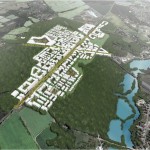New Jersey Future Blog
Proposed Rule Change Would Allow Development on Piers
September 18th, 2017 by David Kutner
New Jersey Future comments urge DEP not to relax existing restrictions.

Ocean pier in Atlantic City. Proposed rule amendments would allow more development in such high-hazard areas. Photo courtesy U.S. Army Corps of Engineers.
New Jersey Future has submitted comments to the Department of Environmental Protection urging the department to reverse its determination that development in high-hazard areas is acceptable and should be permitted. Our comments relate specifically to the proposed revisions to sections 7:7-9.18 of various rules that govern development in coastal high-hazard areas – that is, V or VE FEMA flood zones, and over existing ocean piers and/or pilings in the Hudson River Waterfront area and Atlantic City. The proposed amendments would permit residential and commercial development in these coastal high-hazard areas.
Our comments cite several reasons we believe the department’s determination should be reconsidered, including:
- Perhaps most importantly, development on piers and platforms within high-hazard areas is dangerous to public safety, and places first responders at great risk;
- The rule amendments proposed by the department do not account for projected sea-level rise or climate change. Projections indicate that Atlantic City and municipalities along the Hudson River will experience increasing flooding due to sea-level rise. Unless these factors are taken into account, we will continue with development practices that put people and property in harm’s way. The recent storms in Florida and Texas forced unprecedented evacuation, necessitated massive rescue efforts, and will require billions of dollars for rebuilding and recovery, to a large extent because development was permitted in areas at imminent risk;
- If a municipality approved development in these areas it would risk becoming ineligible to participate in the National Flood Insurance Program, jeopardizing its ability to insure assets against future flooding damage. This was the explicit reason for the governor’s veto in August 2013 of a proposed rule amendment very similar to the one the department is considering now.
Hurricanes Sandy, and Katrina, and Harvey, and Irma, and countless Nor’easters along New Jersey’s coast, have demonstrated repeatedly that the short-term return from tax-generating development in high-risk flood zones will not compensate for the recurring and future costs of recovery and rebuilding, or the threat to public health and safety. Therefore, we are urging the department to reverse course and, rather than allow development in high risk areas, help municipalities to promote land use patterns that acknowledge science-based projections of rising sea levels and help to keep people and property out of harm’s way.
Read New Jersey Future’s full comments.
















